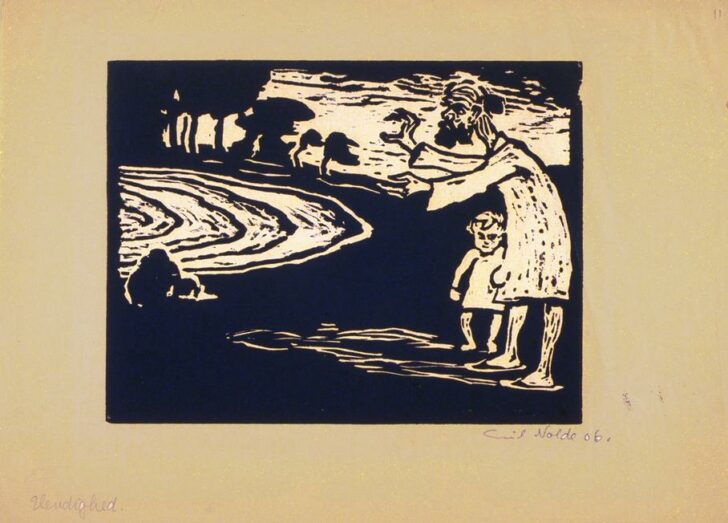Verzweiflung (Despair)
Emil Nolde

Description
March 28, 2009
Already a prolific etcher, Emil Nolde learned the art of woodcut during his brief association with Die Brücke (The Bridge) in the years 1906 and 1907. This work from 1906 is part of the artist’s series Märchen (Fairy Tales), made up of ten woodcuts illustrating individual scenes loosely adapted from folk legends, proverbs, and Bavarian glass painting.
Despair is an excellent example of Nolde’s early mastery of this print technique. He often incorporated the knots, grains, and inherent imperfections of the wood into his printed works. In Despair we see the impulse not only to make the grain visible but to incorporate it as the basis for the flowing waves of the water, the windblown clouds overhead, and the bent posture of the man at the water’s edge. A further example of Nolde’s skill is seen in the bush at the left of the composition, which the artist added using either wood plugs or putty to fill in a previously carved area. The addition creates a formal delineation between foreground and background, giving the entire work a depth it would not otherwise possess.
Subject Matter:
Already a prolific etcher, Emil Nolde learned the art of woodcut during his brief association with Die Brücke in the years 1906 and 1907. This work from 1906 is part of the artist’s series Märchen (Fairy Tales), made up of ten woodcuts illustrating individual scenes loosely adapted from folk legends, proverbs, and Bavarian glass painting.
In Despair we see an excellent example of Nolde’s early mastery of this print technique. He often incorporated the knots, grains, and inherent imperfections of the wood into his printed works. In this early print we see this impulse not only to make the grain visible but to incorporate it as the basis for the flowing waves of the water, the windblown clouds overhead, and the bent posture of the man at the water’s edge. Further example of his early skill is seen in the bush at the left of the composition, which the artist added using either wood plugs or putty to fill in a previously carved area. The addition creates a formal delineation between foreground and background, giving the entire work a depth it would not otherwise possess.
Physical Description:
Print featuring a image of a small boy and a bearded man standing at right near a body of water on left. Small bush at left and trees in the distance.
Usage Rights:
If you are interested in using an image for a publication, please visit https://umma.umich.edu/request-image/ for more information and to fill out the online Image Rights and Reproductions Request Form.